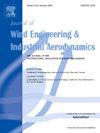悬浮转向架结构气动载荷对600 km/h EMS磁悬浮列车动力性能的影响
IF 4.2
2区 工程技术
Q1 ENGINEERING, CIVIL
Journal of Wind Engineering and Industrial Aerodynamics
Pub Date : 2025-03-07
DOI:10.1016/j.jweia.2025.106070
引用次数: 0
摘要
当EMS高速磁悬浮列车运行速度提高到600 km/h时,气动效应对运行安全性和稳定性影响显著。然而,大多数研究都是将气动载荷作用于车体质心,忽略了气动载荷对转向架结构(如裙板和悬浮/导向电磁铁)的影响。本研究考察了中国600公里/小时磁悬浮列车的动力性能。开发了一个三节车厢列车的空气动力学模型,以模拟600公里/小时的运行条件,包括开放线路和隧道场景。创新性地分析了裙板、悬浮和导向电磁铁的气动载荷,并将其应用到考虑裙板的磁悬浮列车动力学模型中。结果表明,列车前后悬浮转向架上的气动载荷最为显著,其中升力和横向力构成了潜在的运行安全风险。在开路作业期间,这些负载的影响最小。然而,在隧道运行工况下,入口波与压力波相互作用会产生较大的波动,增加了动力响应,可能危及安全性和悬浮稳定性,甚至带来悬浮失稳问题。本文章由计算机程序翻译,如有差异,请以英文原文为准。
Influence of levitation bogie structure aerodynamic loads on the dynamic performance of 600 km/h EMS maglev train
As the operating speed of EMS high-speed maglev trains increases to 600 km/h, aerodynamic effects significantly impact running safety and stability. However, most studies considering aerodynamic loads by applying them to the carbody's mass center, overlooking the aerodynamic loads effects on bogie structures, such as skirt boards and levitation/guiding electromagnets. This study examines the dynamic performance of a Chinese 600 km/h maglev train. An aerodynamic model of a three-car trainset was developed to simulate running conditions at 600 km/h, both in open-line and tunnel scenarios. Aerodynamic loads on skirt boards, levitation, and guidance electromagnets were innovatively analyzed and applied to a maglev train dynamics model considering the skirt board. The findings reveal that aerodynamic loads on the levitation bogie at the train's front and rear are most significant, with lift and lateral forces posing potential running safety risks. During open-line operation, these loads exert minimal impact. However, in tunnels running condition, significant fluctuations occur during entry and pressure wave interactions, increasing dynamic responses and potentially compromising safety and levitation stability, and even bring levitation instability problem.
求助全文
通过发布文献求助,成功后即可免费获取论文全文。
去求助
来源期刊
CiteScore
8.90
自引率
22.90%
发文量
306
审稿时长
4.4 months
期刊介绍:
The objective of the journal is to provide a means for the publication and interchange of information, on an international basis, on all those aspects of wind engineering that are included in the activities of the International Association for Wind Engineering http://www.iawe.org/. These are: social and economic impact of wind effects; wind characteristics and structure, local wind environments, wind loads and structural response, diffusion, pollutant dispersion and matter transport, wind effects on building heat loss and ventilation, wind effects on transport systems, aerodynamic aspects of wind energy generation, and codification of wind effects.
Papers on these subjects describing full-scale measurements, wind-tunnel simulation studies, computational or theoretical methods are published, as well as papers dealing with the development of techniques and apparatus for wind engineering experiments.

 求助内容:
求助内容: 应助结果提醒方式:
应助结果提醒方式:


